Impact of Oxygen Vacancy on the Photo-Electrical Properties of In2O3-Based Thin-Film Transistor by Doping Ga
Abstract
:1. Introduction
2. Device Fabrication and Characterization
3. Results and Discussion
4. Conclusions
Author Contributions
Funding
Conflicts of Interest
References
- Kumomi, H.; Kamiya, T.; Hosono, H. Advances in oxide thin-film transistors in recent decade and their future. ECS Trans. 2015, 67, 3–8. [Google Scholar] [CrossRef]
- Nomura, K.; Ohta, H.; Takagi, A.; Kamiya, T.; Hirano, M.; Hosono, H. Room-temperature fabrication of transparent flexible thin-film transistors using amorphous oxide semiconductors. Nature 2004, 432, 488–492. [Google Scholar] [CrossRef] [PubMed]
- Choi, C.-H.; Han, S.-Y.; Su, Y.-W.; Fang, Z.; Lin, L.-Y.; Cheng, C.-C.; Chang, C.-H. Fabrication of high-performance, low-temperature solution processed amorphous indium oxide thin-film transistors using a volatile nitrate precursor. J. Mater. Chem. C 2015, 3, 854–860. [Google Scholar] [CrossRef]
- Korotcenkov, G.; Brinzari, V.; Cho, B.K. In2O3 -based multicomponent metal oxide films and their prospects for thermoelectric applications. Solid State Sci. 2016, 52, 141–148. [Google Scholar] [CrossRef]
- Sang, L.; Liao, M.; Sumiya, M. A comprehensive review of semiconductor ultraviolet photodetectors: From thin film to one-dimensional nanostructures. Sensors 2013, 13, 10482–10518. [Google Scholar] [CrossRef] [PubMed]
- Armstrong, A.M.; Klein, B.; Allerman, A.A.; Douglas, E.A.; Baca, A.G.; Crawford, M.H.; Pickrell, G.W.; Sanchez, C.A. Visible-blind and solar-blind detection induced by defects in ALGaN high electron mobility transistors. J. Appl. Phys. 2018, 123, 114502. [Google Scholar] [CrossRef]
- Orita, M.; Ohta, H.; Hirano, M.; Hosono, H. Deep-ultraviolet transparent conductive β-Ga2O3 thin films. Appl. Phys. Lett. 2000, 77, 4166–4168. [Google Scholar] [CrossRef]
- Guo, D.Y.; Wu, Z.P.; An, Y.H.; Guo, X.C.; Chu, X.L.; Sun, C.L.; Li, L.H.; Li, P.G.; Tang, W.H. Oxygen vacancy tuned ohmic-schottky conversion for enhanced performance in β-Ga2O3 solar-blind ultraviolet photodetectors. Appl. Phys. Lett. 2014, 105, 023507. [Google Scholar] [CrossRef]
- Higashiwaki, M.; Sasaki, K.; Murakami, H.; Kumagai, Y.; Koukitu, A.; Kuramata, A.; Masui, T.; Yamakoshi, S. Recent progress in Ga2O3 power devices. Semicond. Sci. Technol. 2016, 31, 034001. [Google Scholar] [CrossRef]
- Stanish, P.C.; Radovanovic, P.V. Energy transfer between conjugated colloidal Ga(2)O(3) and cdse/cds core/shell nanocrystals for white light emitting applications. Nanomaterials 2016, 6, 32. [Google Scholar] [CrossRef] [PubMed]
- Wang, H.; Zhou, Q.; Liang, S.; Wen, R. Fabrication and characterization of ALGaN-based UV LEDs with a ITO/Ga(2)O(3)/Ag/Ga(2)O(3) transparent conductive electrode. Nanomaterials 2019, 9, 66. [Google Scholar] [CrossRef] [PubMed]
- Parthiban, S.; Kwon, J.-Y. Role of dopants as a carrier suppressor and strong oxygen binder in amorphous indium-oxide-based field effect transistor. J. Mater. Res. 2014, 29, 1585–1596. [Google Scholar] [CrossRef]
- Nomura, K.; Takagi, A.; Kamiya, T.; Ohta, H.; Hirano, M.; Hosono, H. Amorphous oxide semiconductors for high-performance flexible thin-film transistors. Jpn. J. Appl. Phys. 2006, 45, 4303–4308. [Google Scholar] [CrossRef]
- Pacchioni, G. Oxygen vacancy: The invisible agent on oxide surfaces. Chemphyschem 2003, 4, 1041–1047. [Google Scholar] [CrossRef] [PubMed]
- Reddy, Y.A.K.; Shin, Y.B.; Kang, I.-K.; Lee, H.C. Effect of sputtering pressure on microstructure and bolometric properties of Nb:TiO2−x films for infrared image sensor applications. J. Appl. Phys. 2016, 119, 044504. [Google Scholar] [CrossRef]
- Chen, K.-Y.; Hsu, C.-C.; Yu, H.-C.; Peng, Y.-M.; Yang, C.-C.; Su, Y.-K. The effect of oxygen vacancy concentration on indium gallium oxide solar blind photodetector. IEEE Trans. Electron Devices 2018, 65, 1817–1822. [Google Scholar] [CrossRef]
- Li, S.-S.; Su, Y.-K. Oxygen-vacancy induced resistive switching effect in mn-doped zno memory devices. Phys. Status Solidi (RRL)-Rapid Res. Lett. 2018, 13, 1800453. [Google Scholar] [CrossRef]
- Swann, S. Magnetron sputtering. Phys. Technol 1988, 19, 67. [Google Scholar] [CrossRef]
- Zou, Y.; Zhang, Y.; Hu, Y.; Gu, H. Ultraviolet detectors based on wide bandgap semiconductor nanowire: A review. Sensors 2018, 18, 2072. [Google Scholar] [CrossRef] [PubMed]
- Ivanoff Reyes, P.; Ku, C.-J.; Duan, Z.; Xu, Y.; Garfunkel, E.; Lu, Y. Reduction of persistent photoconductivity in ZnO thin film transistor-based UV photodetector. Appl. Phys. Lett. 2012, 101, 031118. [Google Scholar] [CrossRef]
- Zhou, S.; Fang, Z.; Ning, H.; Cai, W.; Zhu, Z.; Wei, J.; Lu, X.; Yuan, W.; Yao, R.; Peng, J. Bias stability enhancement in thin-film transistor with a solution-processed ZrO2 dielectric as gate insulator. Appl. Sci. 2018, 8, 806. [Google Scholar] [CrossRef]
- Jun, T.; Song, K.; Jung, Y.; Jeong, S.; Moon, J. Bias stress stable aqueous solution derived y-doped ZnO thin film transistors. J. Mater. Chem. 2011, 21, 13524–13529. [Google Scholar] [CrossRef]
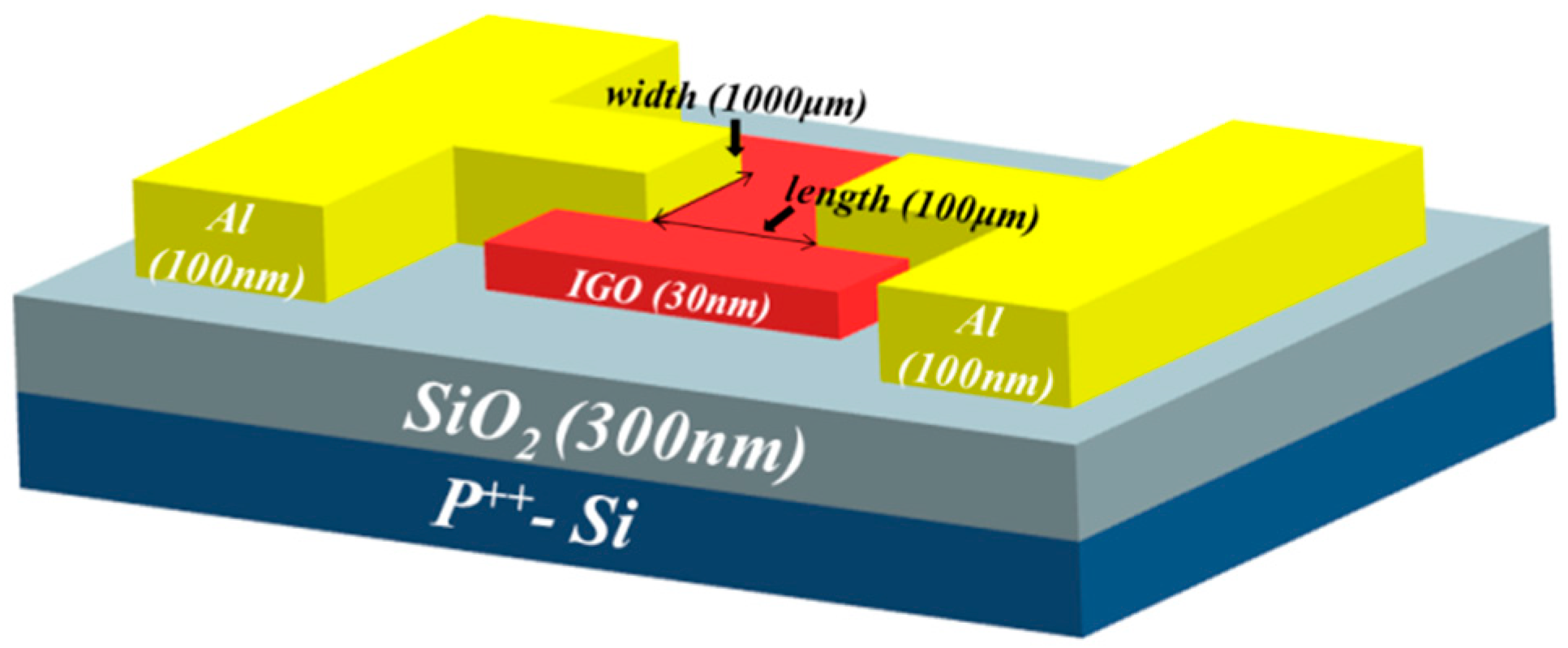
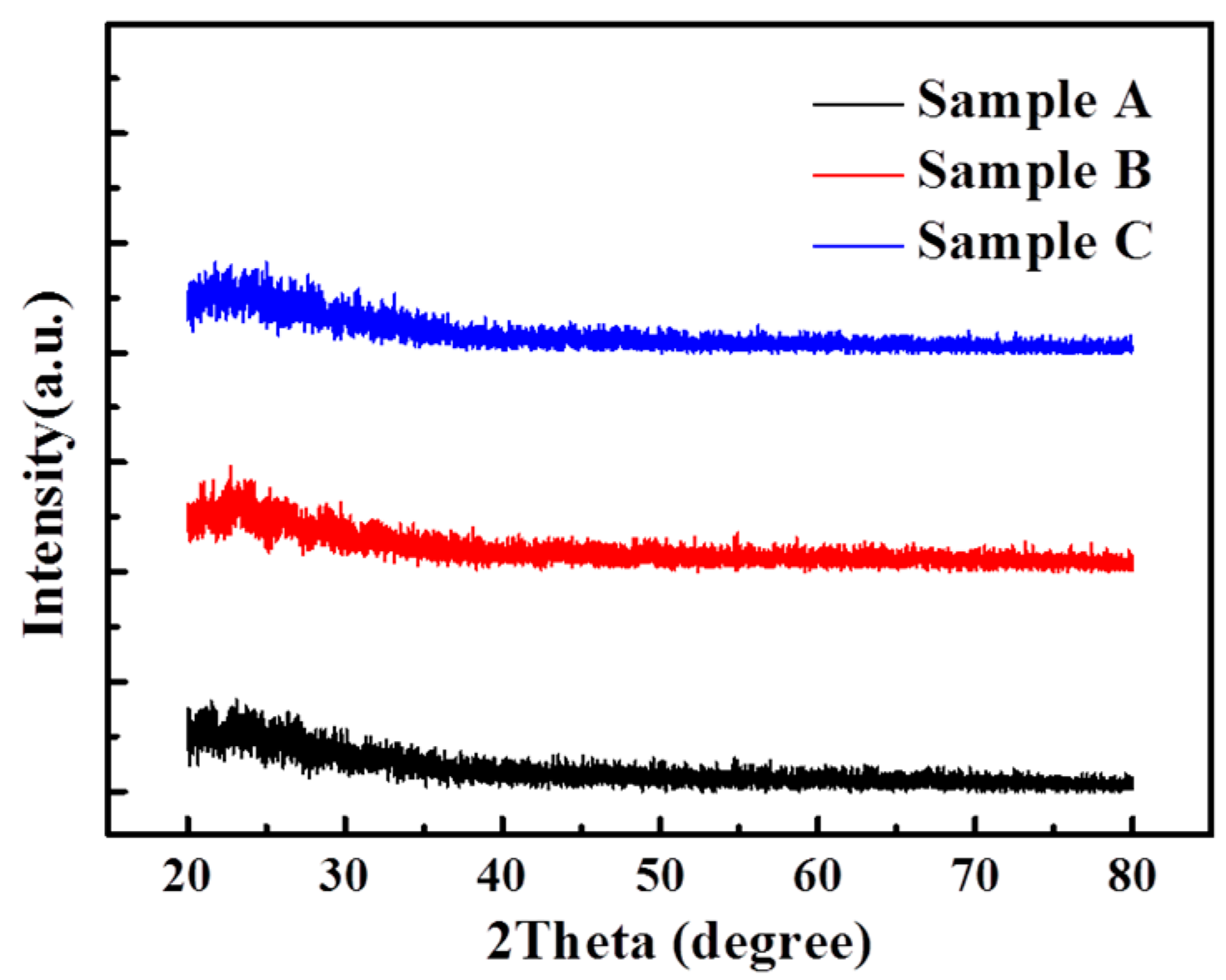
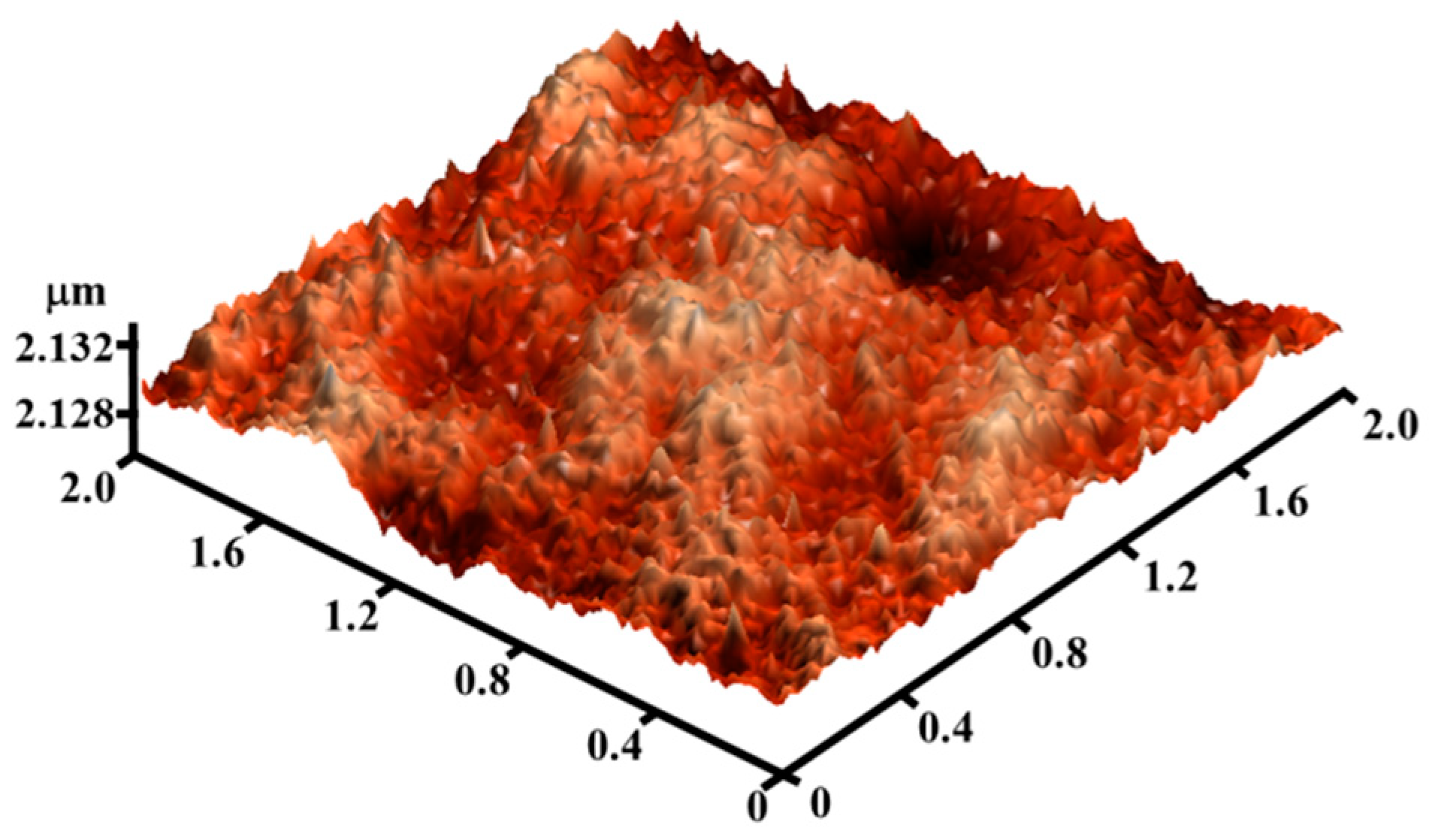
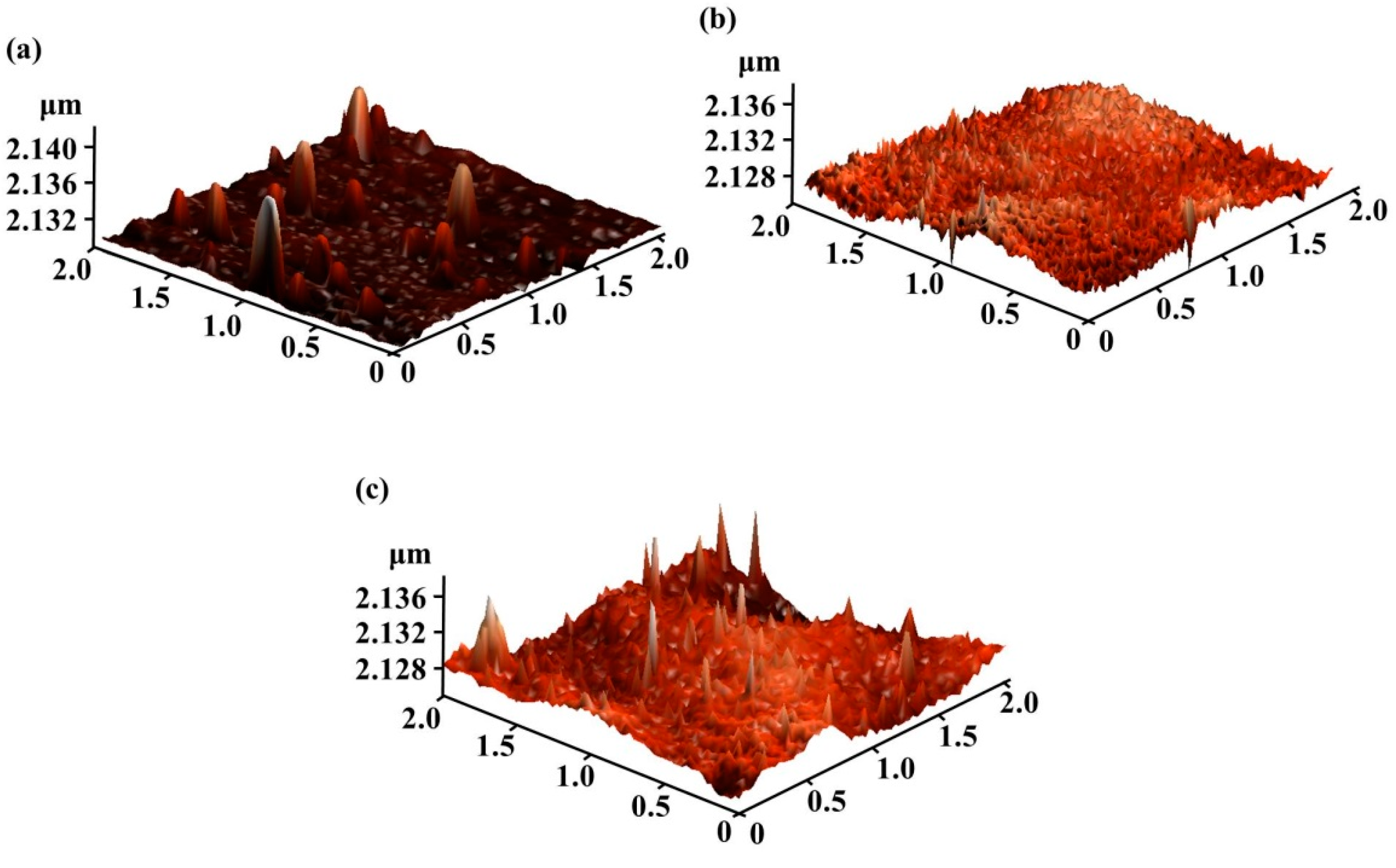
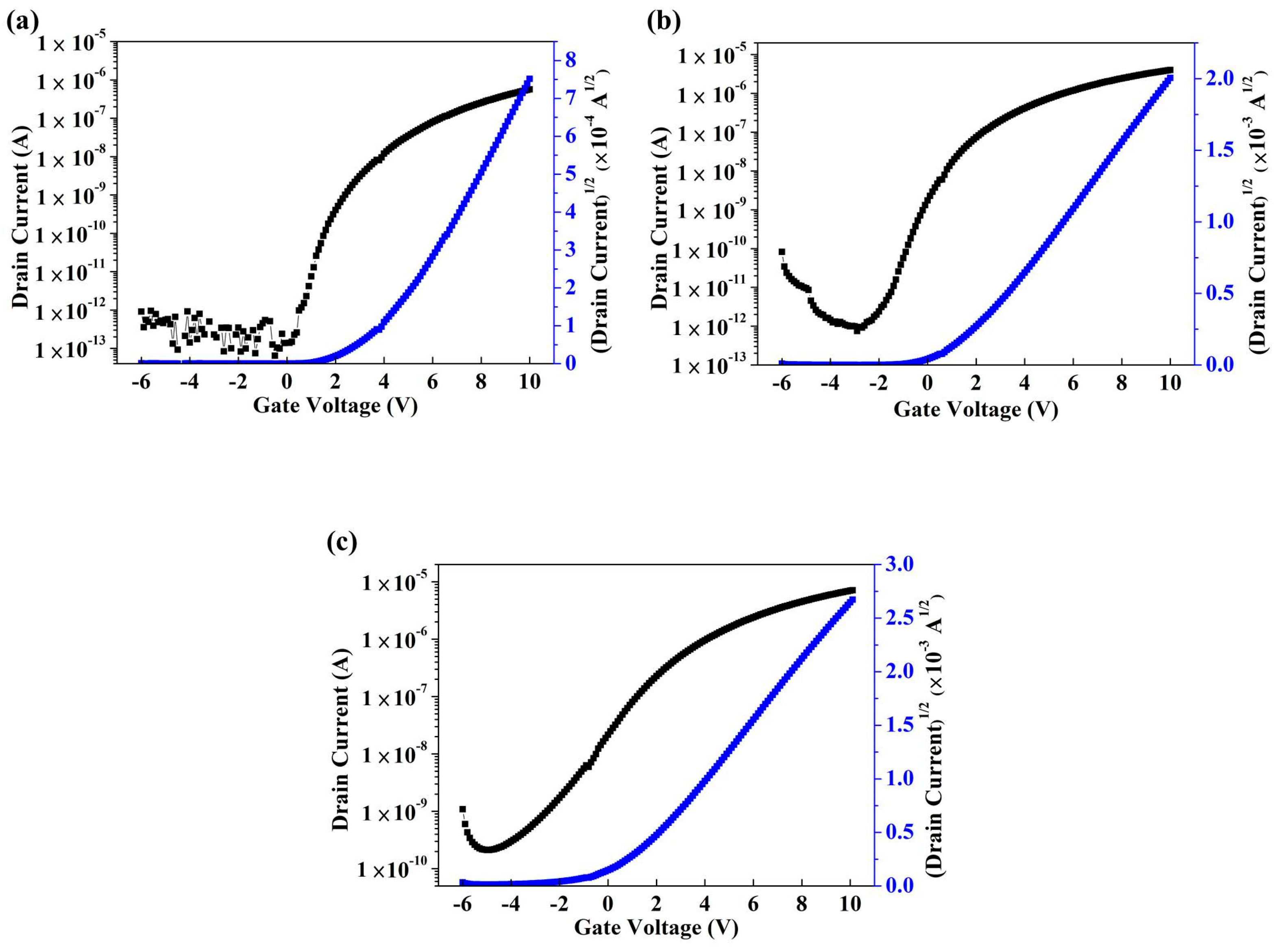
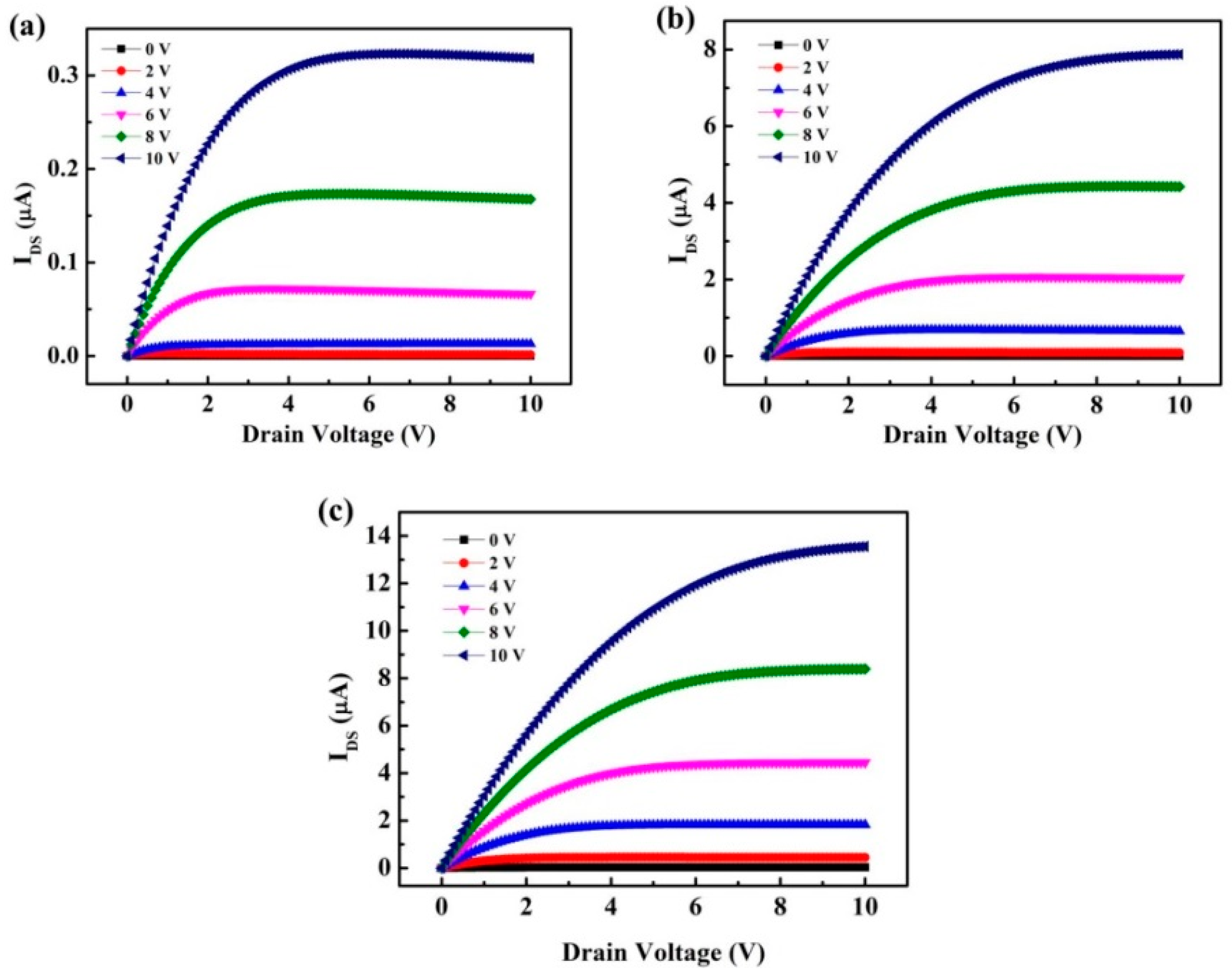


| Ion/Ioff Ratio | S.S (V/dec) | μFE (cm2/Vs) | VTH (V) | |
|---|---|---|---|---|
| Sample A | 4.3 × 105 | 0.526 | 0.4 | 3.7 |
| Sample B | 4.5 × 106 | 3.82 | 1.45 | 1.1 |
| Sample C | 4 × 104 | 8.3 | 2.26 | 0.6 |
© 2019 by the authors. Licensee MDPI, Basel, Switzerland. This article is an open access article distributed under the terms and conditions of the Creative Commons Attribution (CC BY) license (http://creativecommons.org/licenses/by/4.0/).
Share and Cite
Chen, K.-Y.; Yang, C.-C.; Su, Y.-K.; Wang, Z.-H.; Yu, H.-C. Impact of Oxygen Vacancy on the Photo-Electrical Properties of In2O3-Based Thin-Film Transistor by Doping Ga. Materials 2019, 12, 737. https://doi.org/10.3390/ma12050737
Chen K-Y, Yang C-C, Su Y-K, Wang Z-H, Yu H-C. Impact of Oxygen Vacancy on the Photo-Electrical Properties of In2O3-Based Thin-Film Transistor by Doping Ga. Materials. 2019; 12(5):737. https://doi.org/10.3390/ma12050737
Chicago/Turabian StyleChen, Kuan-Yu, Chih-Chiang Yang, Yan-Kuin Su, Zi-Hao Wang, and Hsin-Chieh Yu. 2019. "Impact of Oxygen Vacancy on the Photo-Electrical Properties of In2O3-Based Thin-Film Transistor by Doping Ga" Materials 12, no. 5: 737. https://doi.org/10.3390/ma12050737
APA StyleChen, K.-Y., Yang, C.-C., Su, Y.-K., Wang, Z.-H., & Yu, H.-C. (2019). Impact of Oxygen Vacancy on the Photo-Electrical Properties of In2O3-Based Thin-Film Transistor by Doping Ga. Materials, 12(5), 737. https://doi.org/10.3390/ma12050737






